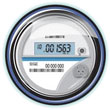Are smart meters a secret ploy to control consumer’s usage via big bad government or are they a consumer friendly device that will enhance the benefits of electric competition by allowing customers to see the real price of electricity, save money and improve grid reliability?
In Pennsylvania, grassroots groups known as the “Tea Party” are voicing their concerns ver smart meters stemming from their distrust of state government. Group members in Duquesne Light’s territory, around Pittsburgh, sent around emails encouraging others to respond negatively to a survey asking residents for information to aid in the installation of smart meters. Specifically, the survey asks consumers for usage information to help determine time-of-use rates.
In response, grassroots members expressed worries about invasion of privacy and government being able to shut-off their power. But these fears stem from smart meter debacles in other states and are in fact the opposite of how consumers should view smart meters.
Competitive Enterprise Institute’s William Yeatmen explains that while the idea of smart meters is a win-win, the implementation is often botched by state government, rendering the new technology useless to the consumer.
In Maryland, the Public Service Commission denied Baltimore Gas & Electric’s smart grid proposal, which included the installation of a smart meter that did not allow the customer to see changes in electricity prices. True transparency of pricing signals is the whole point of any grid modernization plan. But when the incentives for a utility are to reap large rewards by promoting vague principles like efficient use and conservation of energy, regardless of their actual success, companies concentrate on the most costly improvements that need continual upgrades. Often times, those improvements do not result in increased consumer control.
As a result of this rent-seeking policy, a July heat wave inconvenienced thousands of customers in the Chesapeake Bay State. With record breaking temperatures, Baltimore Gas & Electric Co. resorted to turning off air conditioners at businesses and homes, which agreed to give the utility control over their thermostats at peak periods in return for cash, to avoid rolling blackouts. Not surprisingly, many Marylanders were upset and blamed the utility for the shortage of cool air.
If true two-way smart meters had been installed, customers would have turned the air down themselves as they watched the price of electricity soar. In other words, peak demand would flatten naturally.
Unfortunately, Maryland public officials don’t believe that ratepayers are fit to manage their electricity use. In contrast, Pennsylvania’s smart meter law places a cap on how much utilities can spend to install the two-way system that will give Pennsylvanians a window into the true price of their electricity.
Transparent smart meter technology allows all consumers to see that the price of electricity is not the same at 4:00 am and 4:00 pm, essential information if we are to keep up with surging energy demands of the future. For many years, the price of electricity has been largely set by elected officials, but controlling any commodity is a privilege and far too important to leave to anyone but energy users. The proper installation of smart meters along with market competition will ensure electricity rates continue to be set by consumers.



